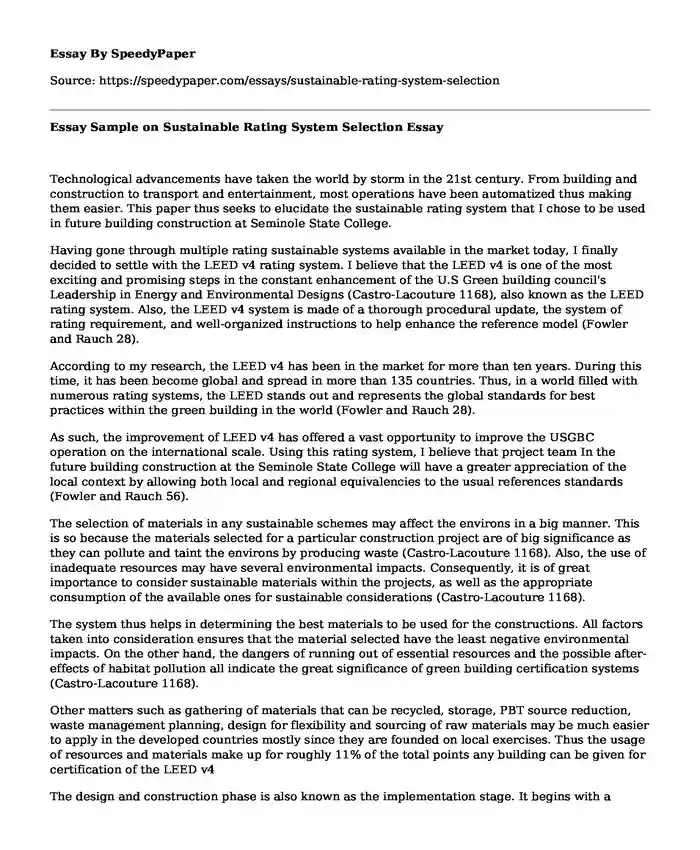
| Type of paper: | Essay |
| Categories: | Engineering |
| Pages: | 3 |
| Wordcount: | 618 words |
Technological advancements have taken the world by storm in the 21st century. From building and construction to transport and entertainment, most operations have been automatized thus making them easier. This paper thus seeks to elucidate the sustainable rating system that I chose to be used in future building construction at Seminole State College.
Having gone through multiple rating sustainable systems available in the market today, I finally decided to settle with the LEED v4 rating system. I believe that the LEED v4 is one of the most exciting and promising steps in the constant enhancement of the U.S Green building council's Leadership in Energy and Environmental Designs (Castro-Lacouture 1168), also known as the LEED rating system. Also, the LEED v4 system is made of a thorough procedural update, the system of rating requirement, and well-organized instructions to help enhance the reference model (Fowler and Rauch 28).
According to my research, the LEED v4 has been in the market for more than ten years. During this time, it has been become global and spread in more than 135 countries. Thus, in a world filled with numerous rating systems, the LEED stands out and represents the global standards for best practices within the green building in the world (Fowler and Rauch 28).
As such, the improvement of LEED v4 has offered a vast opportunity to improve the USGBC operation on the international scale. Using this rating system, I believe that project team In the future building construction at the Seminole State College will have a greater appreciation of the local context by allowing both local and regional equivalencies to the usual references standards (Fowler and Rauch 56).
The selection of materials in any sustainable schemes may affect the environs in a big manner. This is so because the materials selected for a particular construction project are of big significance as they can pollute and taint the environs by producing waste (Castro-Lacouture 1168). Also, the use of inadequate resources may have several environmental impacts. Consequently, it is of great importance to consider sustainable materials within the projects, as well as the appropriate consumption of the available ones for sustainable considerations (Castro-Lacouture 1168).
The system thus helps in determining the best materials to be used for the constructions. All factors taken into consideration ensures that the material selected have the least negative environmental impacts. On the other hand, the dangers of running out of essential resources and the possible after-effects of habitat pollution all indicate the great significance of green building certification systems (Castro-Lacouture 1168).
Other matters such as gathering of materials that can be recycled, storage, PBT source reduction, waste management planning, design for flexibility and sourcing of raw materials may be much easier to apply in the developed countries mostly since they are founded on local exercises. Thus the usage of resources and materials make up for roughly 11% of the total points any building can be given for certification of the LEED v4
The design and construction phase is also known as the implementation stage. It begins with a schematic design and is similar to the standard practice in its organization. However, it combines all the collective understanding and work of the system interfaces that are reached upon throughout the innovation phase. Thus for the certification to be issued, for the LEED new building construction and design, at least 60% of the total floor area must have been completed (Castro-Lacouture 1168).
Work Cited
Castro-Lacouture, D., Sefair, J. A., Florez, L., & Medaglia, A. L. (2009). An optimization model for the selection of materials using a LEED-based green building rating system in Colombia. Building and environment, 44(6), 1162-1170.
Fowler, K. M., & Rauch, E. M. (2006). Sustainable building rating systems summary (No. PNNL-15858). Pacific Northwest National Lab. (PNNL), Richland, WA (United States).
Cite this page
Essay Sample on Sustainable Rating System Selection. (2022, Sep 26). Retrieved from https://speedypaper.net/essays/sustainable-rating-system-selection
Request Removal
If you are the original author of this essay and no longer wish to have it published on the SpeedyPaper website, please click below to request its removal:
- Essay Example on Why Guns Should Be Controlled
- Free Essay on the Effect that Social Network Has on Underage Users
- Annotated Bibliography Example on Police Misconduct
- Essay Sample on Quality of Life for Older People Living
- Essay Sample on Tense relationship
- Essay Sample on FIFO (First-In, First-Out) and LIFO (Last-In, First-Out)
- Essay Sample. Research and Qualitative Study of Mental Illness in Prison
Popular categories




